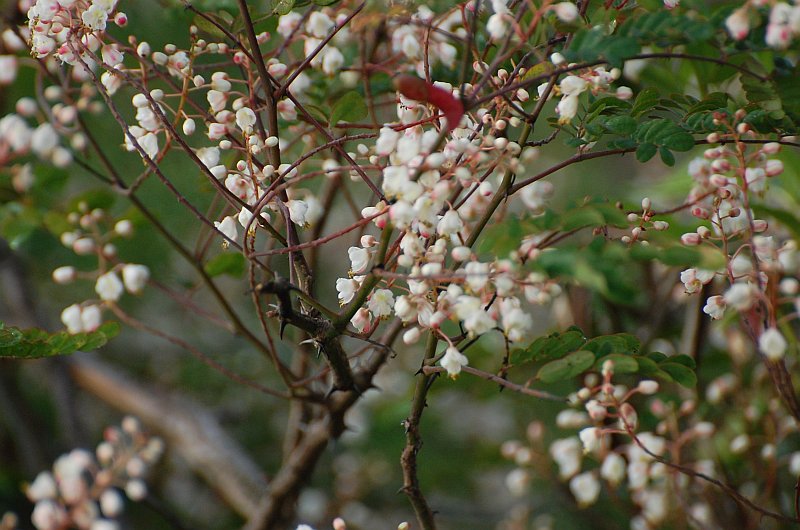|
Pterolobium hexapetalum (Roth) Santapau & Wagh (Syn: Caesalpinia lacerans Roxb.; Caesalpinia ligulata DC.; Cantuffa hexapetala (Roth) Kuntze; Cantuffa lacerans (Roxb.) Taub.; Pterolobium hexapetallum (Roth) Santapau & Wagh [Spelling variant]; Pterolobium indicum A.Rich.; Pterolobium lacerans auct. non R.Br.; Reichardia hexapetala Roth);
.
‘travellers’ terror’;
.
Bangladesh (N); Bhutan (N); India (N) ; Andhra Pradesh ; Karnataka ; Kerala ; Pondicherry ; Sikkim ; Tamil Nadu ; Uttar Pradesh ; West Bengal ; Myanmar (N) as per ILDIS;
..
     Flower ID request | AR02: Flower Opposite, size- small, 1 cms, plant height -2 meters, Chamundi Hills, Mysore– 26 Jul 2008. Yes this is Pterolobium hexapetalum, aptly known as ‘travellers’ terror’. It is good looking when its in flowering. Flowers are very fragrant. But we had had our toughest times with this plant in the field. While damaging your clothes and skin, it will apply frequent brakes during treks, with its spines that point all directions.
260612 BRS386: Pl. find the attached file contain photos for id. request.
Location: Anaikatti, Coimbatore Dist. (640 MSL)
Date: 25.06.2012
Habitat: Wild
Habit: Woody climber? This plant is Pterolobium hexapetalum (Roth) Sant. & Wagh
ID No. MS 110912-100- Pterolobium hexapetalum: Agree with … id. wonder why?
Pterolobium hexapetalum is one of the dominant species in the scrub jungles and foothills. The plants, with their copiously prickled arching branches, form thick and impenetrable cover on the floor, over rocks and also on other bushes and small trees. Thanks … for prompt a reply… you must be up early…and already at work … my wonderment was because the only plant I had remembered as referred to as a terror for travelers was another prickly plant …nettles of some sort… esp in australian scrub… which will inject histamine in the skin its prickles penetrated…. but this plant sounds like a real terror… dont rememebr where I read it.. was a long time ago…
poison ivy and poison sumac are terrors but not to these proportions …
Pterolobium hexapetalum (Roth) Santapau & Wagh SN May 14 : 1 post by 1 author. Attachments (1).
Pterolobium hexapetalum (Roth) Santapau & Wagh,
straggling shrub with hooked spines; common in the scrub jungles of plains and foot hills.
ARJUL30 Thorny shrub for ID : 4 posts by 2 authors. Attachments (3). Fruit- Attachments (1) The fruit pods look like Pterolobium hexapetalum. ANAPR59 Pterolobium hexapetalum (Roth) Santapau & Wagh : 1 post by 1 author. Attachments (11) Family: Caesalpiniaceae
Date: 19th April 2015 Place: Chamarajanagar, Karnataka Habit: Shrub Habitat: Deciduous forest
It is my pleasure to share few images of Pterolobium hexapetalum (Fabaceae)
Habit: Scandent, thorny shrub
Habitat: Wild, Deciduous forest. .
Sighting: Chikmagalur, Karnataka about 1000 msl.
Date: 18-05-2014, 03-08-2014, 08-06-2015 and 18-09-2015
MS/ID/JULY/ 2020/2 -ID of a tree : 6 posts by 3 authors. Attachments (6) For me now it looks like Pterolobium hexapetalum. Further comments are welcome. I guess it is correct ! It was wrongly reported by the sender of the photograph as tree. It is a spiny shrub (recurved spines). Pterolobium hexapetalum. Looks pretty attractive flowers: Any local name? Please check the link for common names.: .
Fabaceae: Pterolobium hexapetalum (Roth) Santapau & Wagh: 1 high res. image.
synonyms: Pterolobium lacerans (Roxb.) Wight & Arn., Pterolobium lacerans Wall., Pterolobium indicum A.Rich. location/date: University of Agricultural Sciences campus, Bangalore, July 1997 References: |
Pterolobium hexapetalum
Updated on December 24, 2024










.jpg?part=0.6&view=1&vt=ANaJVrH-zCmWtRt_Tc9SyLusMqhuOs8yS24ARtF4j3UprtoDFo0uJTdG-2nIz8QwCKbCToDAONunf5A84iL12-fZ1KGpgEI63wX7yP_PikHd20YQwzxaSWE)
.jpg?part=0.4&view=1&vt=ANaJVrFaV1kb2_4b6zR4lenvp1J-XihGynsBRdu_HsacbfTtJY6hRr6UL9uSfj-Vl-K1v4jGx9rb2ybHi_ZdRM9a0cS81wFhKdAEIWNV8iL21VAO_qnO3hQ)
.jpg?part=0.5&view=1&vt=ANaJVrHPUANKIhkFsDAMDjs68N-EY-bwNc19oB1RtynhbIbjYrfv8oM9uUQmH48rys4ERz-tn1rOJtad_I-d55t2egcg-XLTnMNFLR0O745fbkmB7iQpNSw)
.jpg?part=0.3&view=1&vt=ANaJVrH5nb3ZZibyh4ucTkiOdpAw1tDLcKC2tVWk2J30iPfFCBRi7Fspzs8p4MQ3JmtBxYgXFfvIGAWfXceCiltpEay7H_hAM3sVgNVANF9UtHHcW4L0SjU)
.jpg?part=0.2&view=1&vt=ANaJVrH_RvdjOOD-uvmyjBLQy9M2utBxPM5fHmapGSt_P5ND9INXraSppAcm-KxLr73N58REYvr43Y59W0Z3vbIdLqKKGA5VBeKDaNeNCItIy4HfBwddNMk)
.jpg?part=0.1&view=1&vt=ANaJVrETGtFFkFG4iTDg4q0M-mZD7Bw8iNG1qD0TTRh0p5NOrsHXmP_oB8a-Rli78QBvEtwzg4HSy5agQGSrPU3eAqcBOaHFvQfxLd5aFiMkONePVea5VJM)